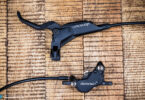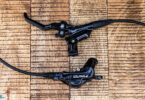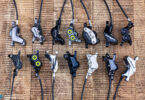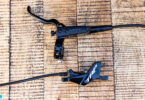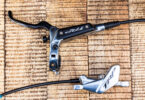EMTB or Enduro? The Specialized S-Works Turbo Kenevo SL Light eMTB looks deceptively similar to its analogue counterpart, the S-Works Enduro. The two bikes also share almost identical specs and countless technical features. This was reason enough for us to pit the bikes against each other in our ultimate bruiser shootout. Which one gets the rowdiest on the trail and is the most fun to ride?
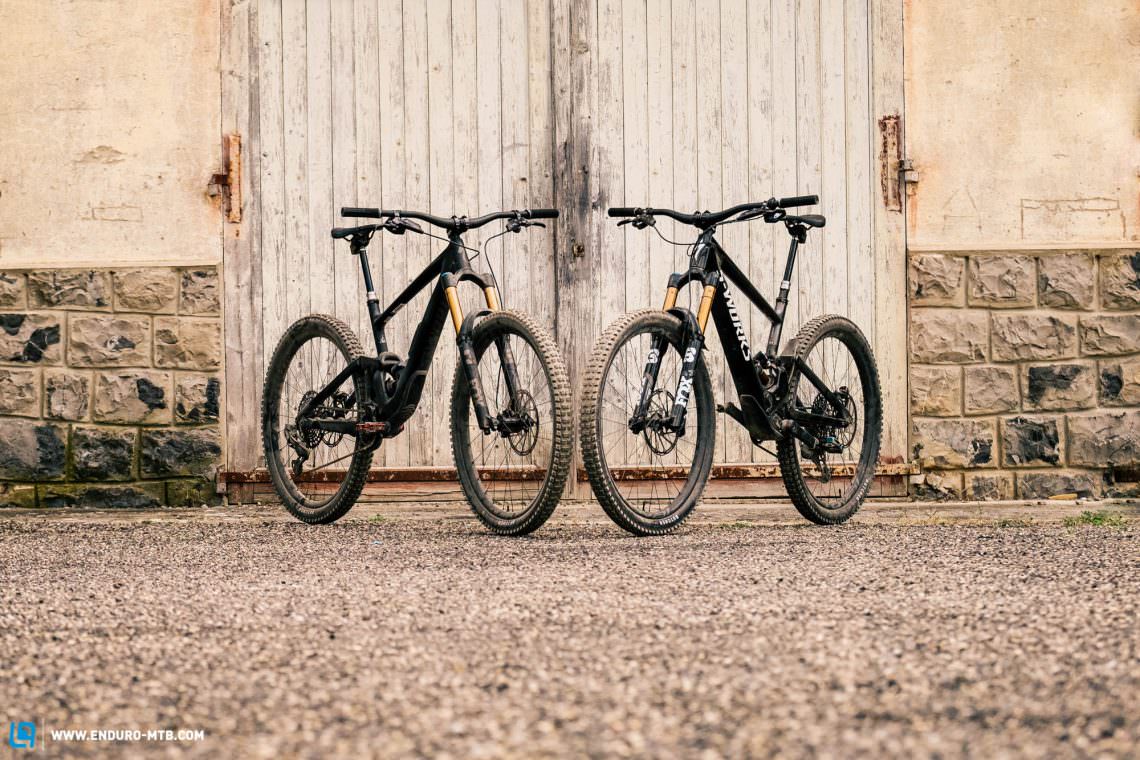
170/170 mm (f/r) | 14.9 kg (size S4 | € 11,999
Specialized S-Works Turbo Kenevo SL (right)
Specialized SL 1.1/320 Wh | 170/170 mm (f/r) | 18.7 kg (size S4) | € 13,999Manufacturer-website
Which one is the eMTB? At first glance, the € 13,999 Specialized S-Works Turbo Kenevo SL looks deceptively similar to its analogue counterpart, the € 11,999 S-Works Enduro. Coincidence? Not at all! The Kenevo SL is no more than the electrified evolution of the Enduro. Unlike its analogue counterpart, it doesn’t leave you to ride to the top of the hill solely under your own steam but provides assistance with its compact Specialized SL 1.1 motor. This churns out 35 Nm torque and draws its power from an internal 320 Wh battery integrated into the down tube. While the small motor is powerful enough to handle leisurely climbs and long tours, it can’t be compared to the bigger and more powerful 2.2 motor of the Levo or similar motors like the Bosch CX. Except for the motor system and weight, the bikes are almost identical: 170 mm travel front and rear, 29” wheels and a spec chosen for uncompromised riding fun.
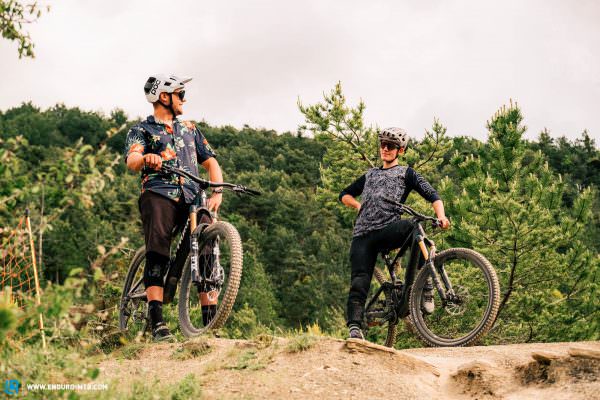
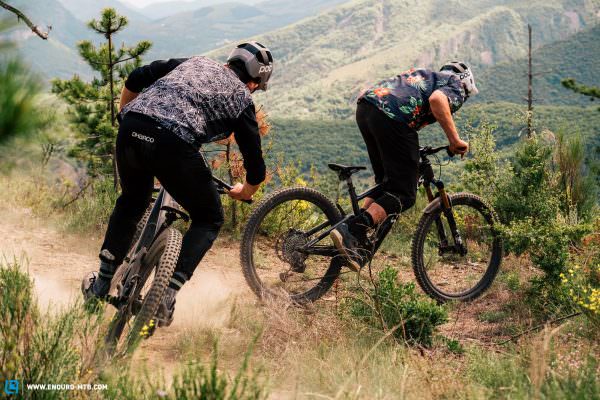

In other words, the ideal prerequisites for a rowdy trail battle! Which Specialized makes the feathers fly on the trail? Can the Light eMTB assert itself against its analogue counterpart or does the Enduro live up to its name, leaving its electric opponent behind in a cloud of dust? To find out, we pitted the 18.7 kg S-Works Turbo Kenevo SL against the 14.9 kg S-Works Enduro. The battle took place across different venues, from the EVO bike park in the foothills of the Southern French Alps, through several race stages of the Enduro World Series all the way to the techiest trails of the Dolomites – and of course, on our flowing home trails around Stuttgart. Did we have fun? Hell yeah, and with both bikes! While at first glance the Enduro and Kenevo SL look uncannily similar, there are some major differences between them.
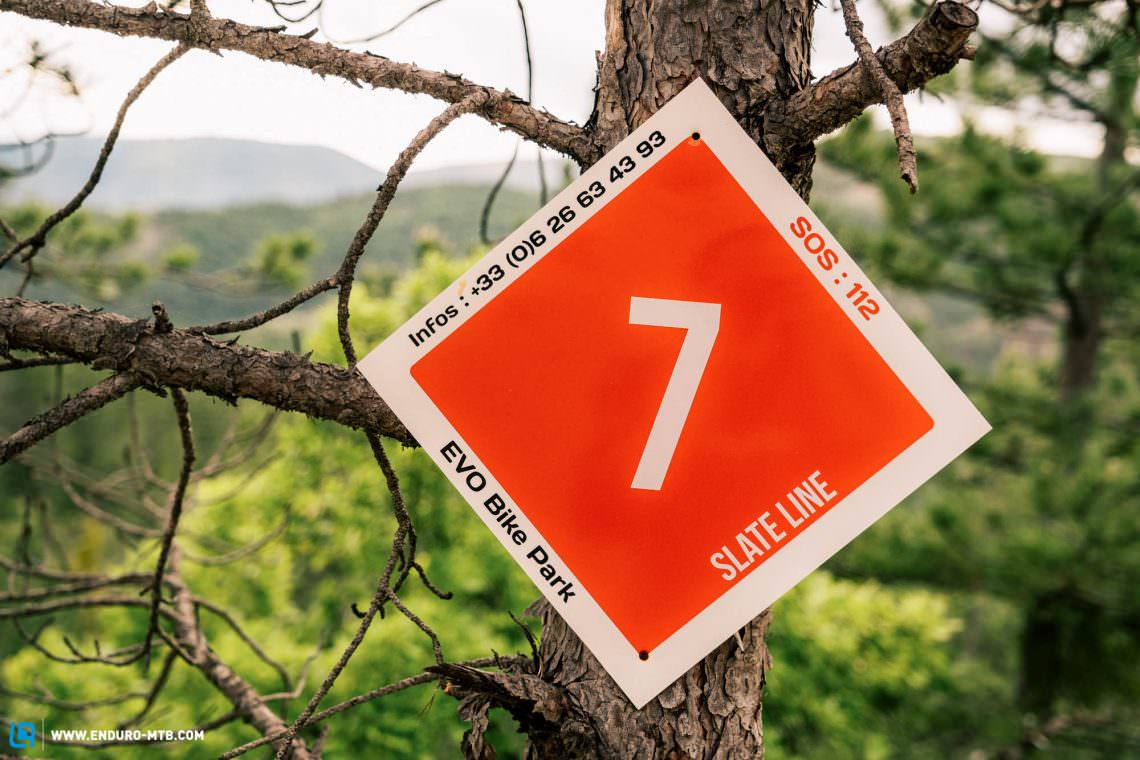
At the EVO bike park in the South of France, the S-Works Enduro and Turbo Kenevo had to prove themselves on steep and technical singletrack and big jump lines.
The spec of our test bikes
Here at ENDURO, we’ve never hosted a shootout where the opponents shared such similar specs. Apart from some small details, the Specialized S-Works Enduro and Turbo Kenevo SL are specced with nearly identical components. On both bikes, the highlight of the spec is the 170 mm FOX Factory suspension with a 38 GRIP2 fork and X2 shock. However, the high-speed rebound dial on the Kenevo SL’s shock is hard to reach. SRAM’s powerful CODE RSC stoppers live up to the eye-watering price of the bikes, providing reliable deceleration, outstanding modulation and excellent heat management in combination with the massive 220 mm rotor at the front and 200 mm disc at the rear. Excellent! Although both bikes rely on a 12-speed SRAM XX1 AXS wireless drivetrain, the Enduro employs a matching X01 carbon crankset while the Kenevo SL has a Praxis Carbon M30 crank arms attached directly to the SL 1.1 motor’s axle. On the Enduro, the 170 mm wireless RockShox Reverb AXS dropper post can be fully inserted into the seat tube. In contrast, the Kenevo SL has a shorter maximum insertion depth, which makes it impossible to push the dopper all the way into the frame. Here, a dropper post with a lower stack height would offer more freedom of movement. On both bikes, the wireless AXS controls mounted on Specialized’s in-house 800 mm Roval Traverse SL carbon handlebars ensure a tidy cockpit. Even on the eMTB, only the brake line and remote cable are visible. As far as the spec goes, our only criticism goes to the wheel/tire combination, which is the same on both bikes. Specialized rely on their own 29″ Roval Traverse SL carbon wheelset and 2.3” Specialized Butcher tires in the GRID Trail casing. The fragile casing doesn’t live up to the rowdy potential of the bikes, offering inadequate puncture protection and making pinch flats and rim damage unavoidable. To unlock the full potential of the bike, we recommend using the same tires in the more robust GRID Gravity casing or upgrading to even more robust tires.

Specialized S-Works Enduro
€ 11,999
Specifications
Motor Nm
Battery Wh
Fork FOX 38 Factory GRIP2 170 mm
Rear Shock FOX X2 Factory 170 mm
Seatpost RockShox Reverb AXS 170 mm
Brakes SRAM CODE RSC 220/200 mm
Drivetrain SRAM XX1 Eagle AXS 1x12
Stem DEITY Copperhead mm
Handlebar Roval Traverse SL Carbon 800 mm
Wheelset Roval Traverse SL 29"
Tires Specialized Butcher GRID TRAIL 2.3"
Technical Data
Size S1 S2 S3 S4 S5
Weight 14.9 kg
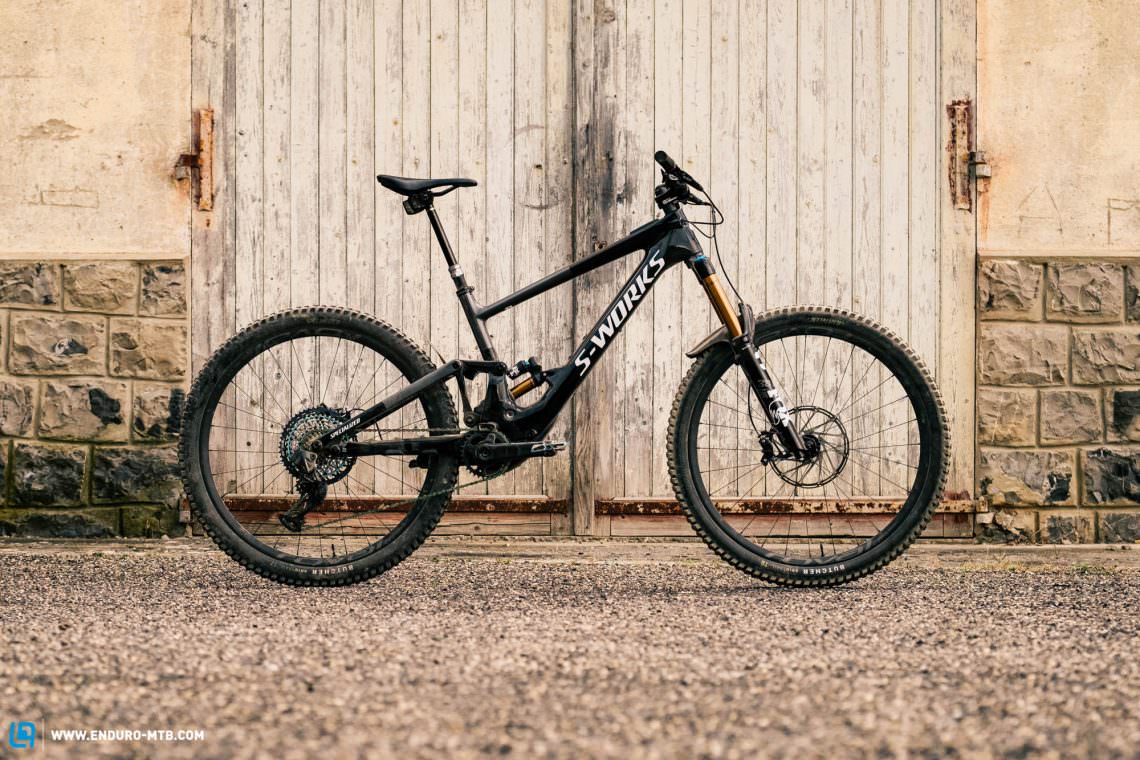
Specialized S-Works Turbo Kenevo SL
€ 13,999
Specifications
Motor Specialized SL 1.1 35 Nm
Battery Specialized SL1 320 Wh
Display Specialized MasterMind
Fork FOX 38 Factory GRIP2 170 mm
Rear Shock FOX X2 Factory 170 mm
Seatpost RockShox Reverb AXS 170 mm
Brakes SRAM CODE RSC 220/200 mm
Drivetrain SRAM XX1 Eagle AXS 1x12
Stem DEITY Copperhead mm
Handlebar Roval Traverse SL Carbon 800 mm
Wheelset Roval Traverse SL 29"
Tires Specialized Butcher GRID TRAIL 2.3"
Technical Data
Size S1 S2 S3 S4 S5
Weight 18.7 kg
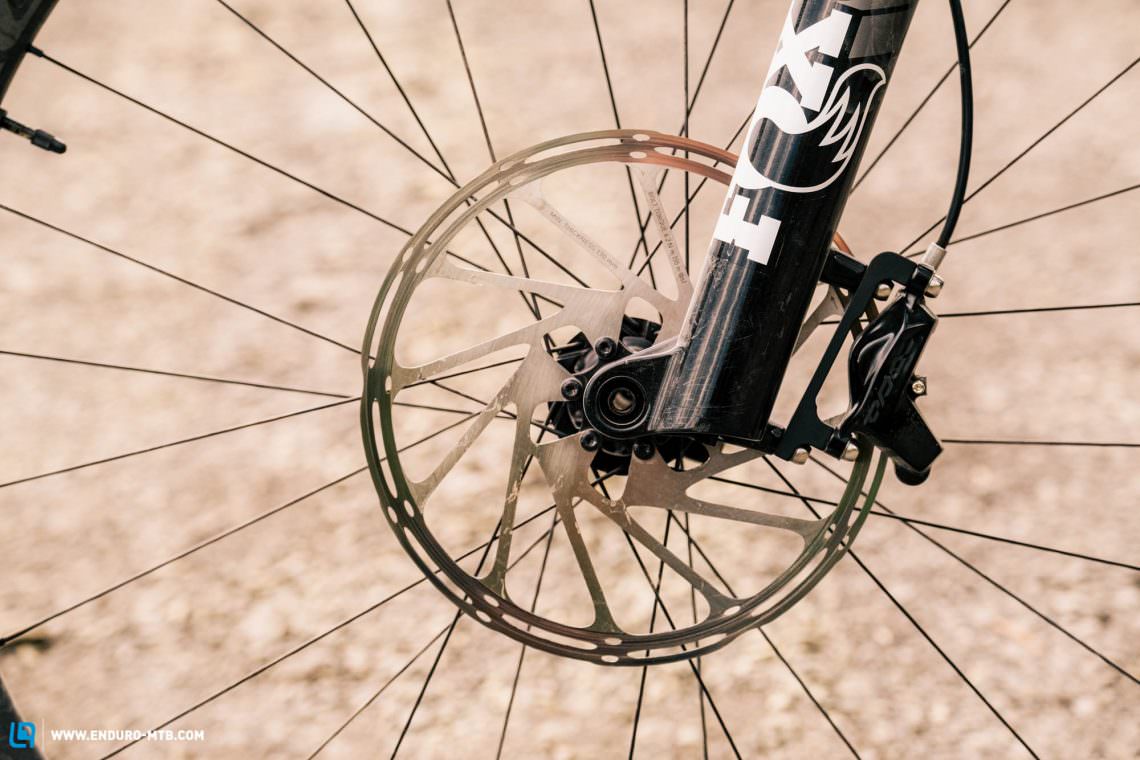
… at least when it comes to braking power. For both bikes, Specialized rely on powerful SRAM CODE RSC brakes with a massive 220 mm rotor at the front and 200 mm disc at the rear.
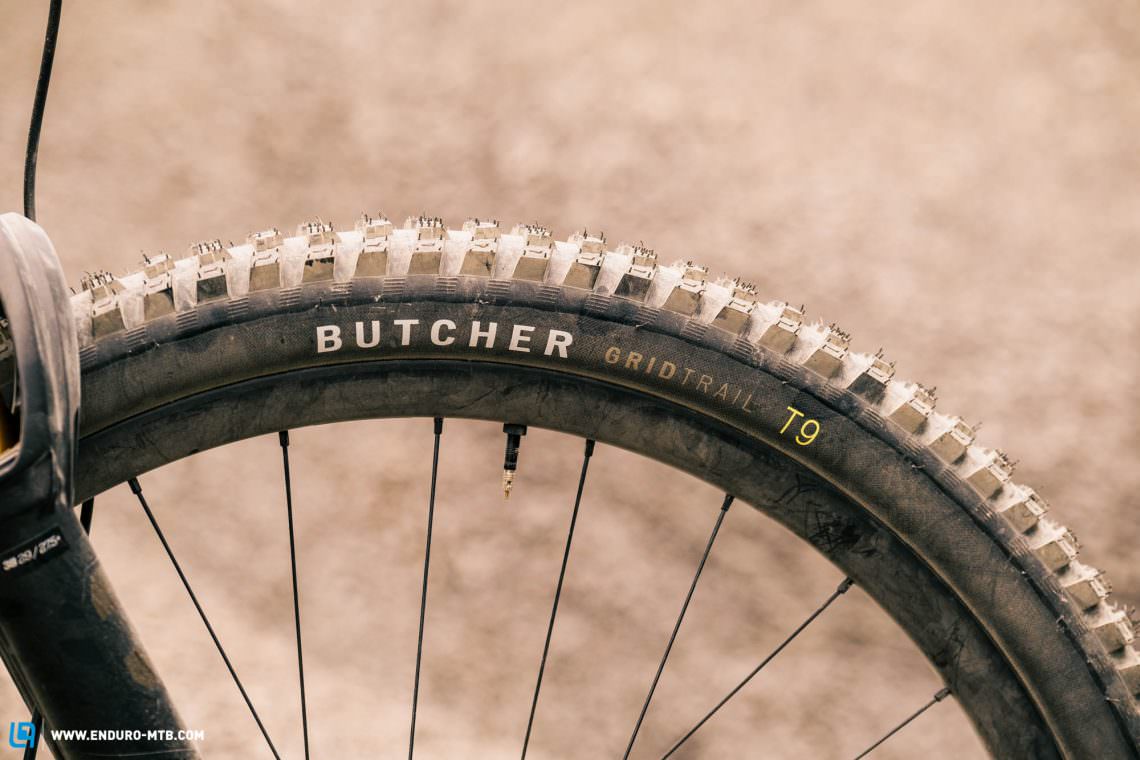
Both the Kenevo SL and the Enduro roll on super-light Roval Traverse SL carbon wheels with Butcher tires in the weak GRID Trailcasing. Unfortunately the latter offers inadequate puncture protection, making pinch flats and rim damage unavoidable.
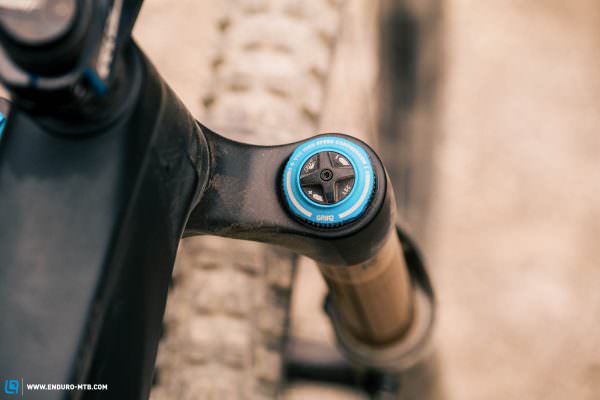
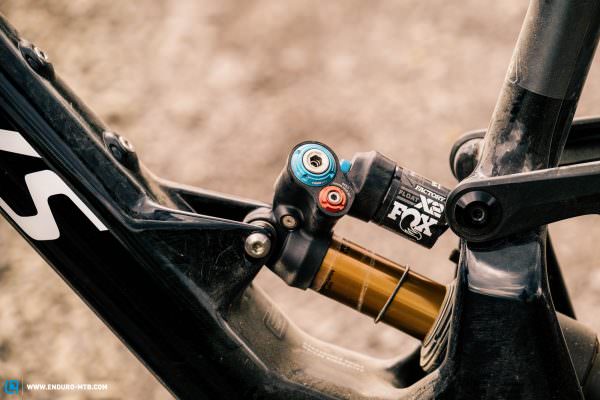
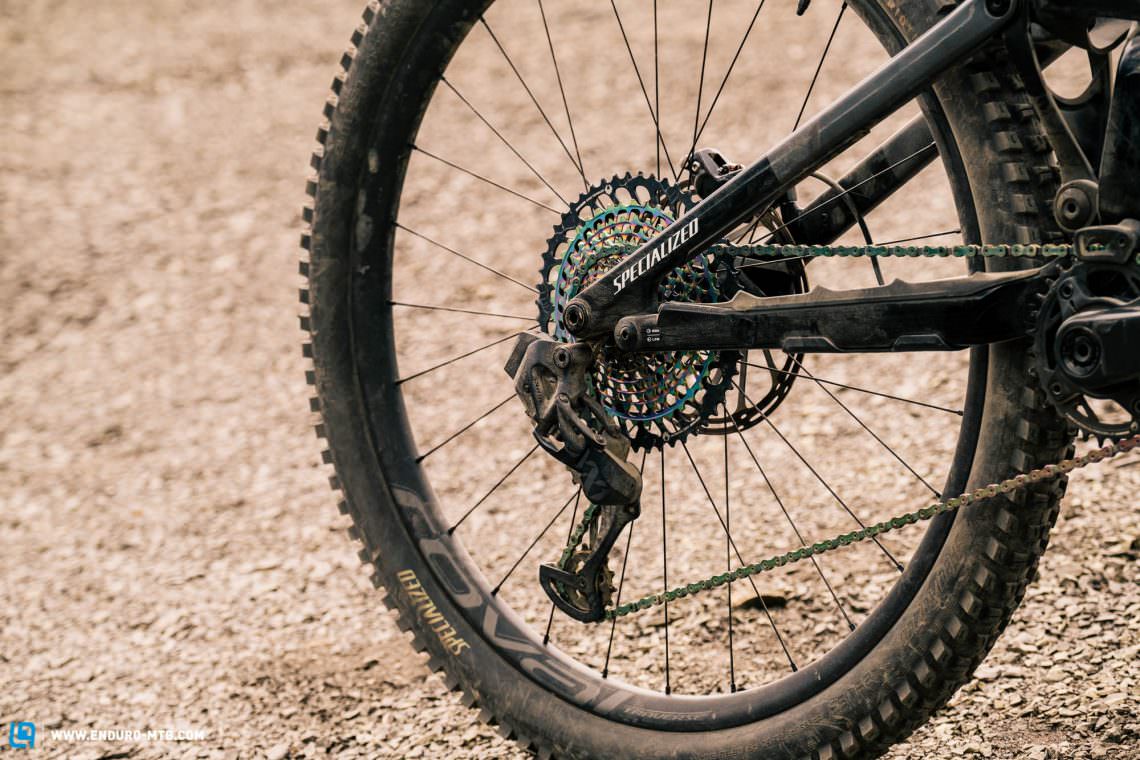
The 12-speed SRAM XX1 Eagle AXS wireless drivetrain delivers quick, precise and crisp gear shifts.
Specialized S-Works Turbo Kenevo SL and S-Works Enduro in detail
As good as it gets! Given that the S-Works designation is exclusive to Specialized’s top-end models, it’s hardly surprising that both the frames and their components are made of carbon – and even some sections of the six-bar FSR rear suspension. While this looks almost identical on both bikes, upon closer inspection you’ll notice that Specialized have adapted the kinematics of the Light eMTB to make room for the motor.


More juice or gummy bears? While the down tube of the Kenevo SL houses the 320 Wh battery of the SL 1.1 motor, the Enduro features a practical storage compartment in the frame which can be accessed via Specialized’s SWAT door. That lets you store all your trail essentials like a spare inner tube, a pump and, of course, a big bag of gummy bears. On gloomy days, you can even use it to carry a compact rain jacket and leave your backpack or hip bag at home. Unfortunately, you can’t do the same with the Kenevo SL. If you’re planning to embark on epic singletrack expeditions with the additional range extender, this will take up room in the bottle cage, leaving no room for a water bottle or trail essentials. Nevertheless, both bikes come with a SWAT multi-tool in the steerer tube.
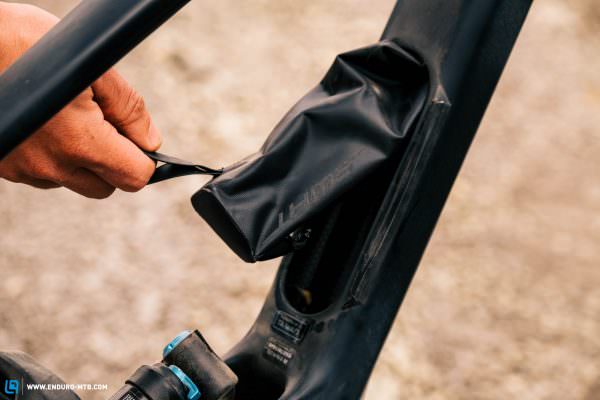
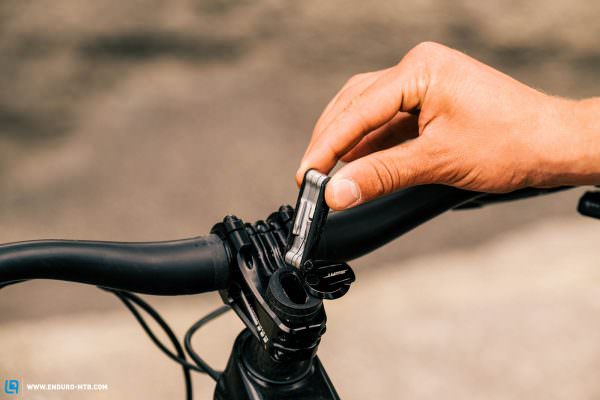
The Specialized SL 1.1 motor of the S-Works Kenevo SL
“2 times you” is the slogan Specialized use to advertise their compact SL 1.1 motor, which has a maximum power output of 240W. The bigger 2.2 motor of the Levo churns out more than twice as much power under maximum load, leaving the Kenevo SL behind in a cloud of dust on steep climbs. On the other hand, the Kenevo SL wasn’t designed to race the shuttle or gondola on your way to the trailhead. Instead, the SL 1.1 motor was developed to take the edge off steep climbs and allow you to squeeze in a few extra laps on a fun day out on the trails – for this purpose, the 320 Wh battery in the down tube is more than sufficient. If you want to embark on motor-assisted enduro expeditions, you can use the optional 160 Wh range extender, which fits into the bottle cage and is connected via a cable to the Levo SL’s charging socket. Overall, the integration of the entire motor system is impeccable. The MasterMind display integrated in the top tube shows you all the most important ride data while the Mission Control app lets you customise the assistance modes and personalise the layout of the display. Only the super compact remote fitted on the cockpit gives away the electric nature of the Kenevo SL.
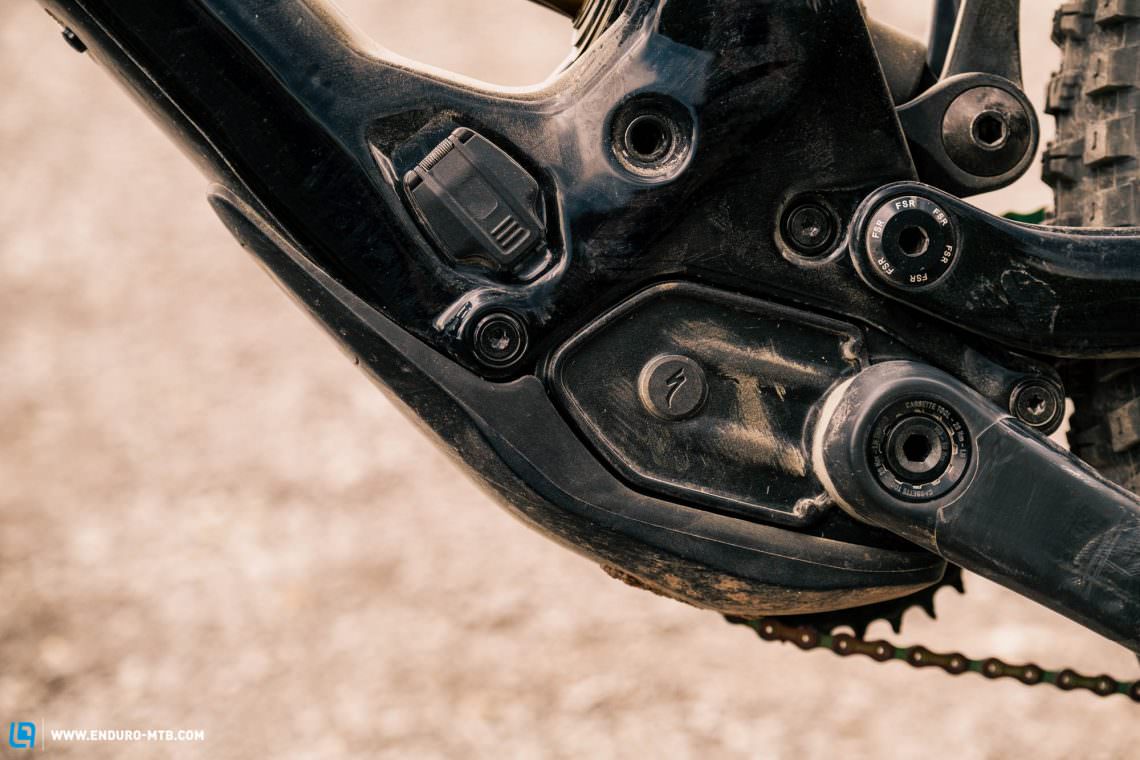
The compact SL 1.1 drive isn’t as powerful as the 2.2 motor of the Levo models and delivers power more inconspicuously, making you feel like you’ve just spent a week at Specialized’s CC World Cup team training camp.

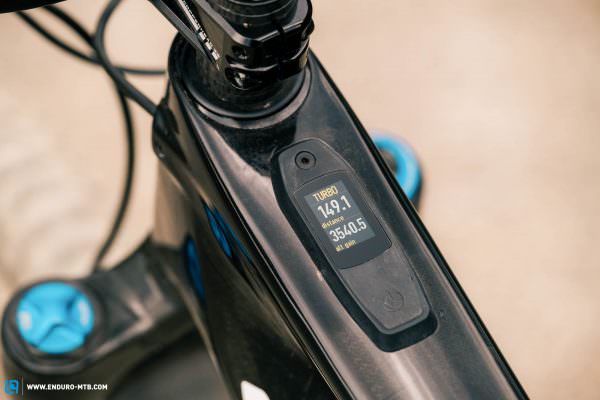
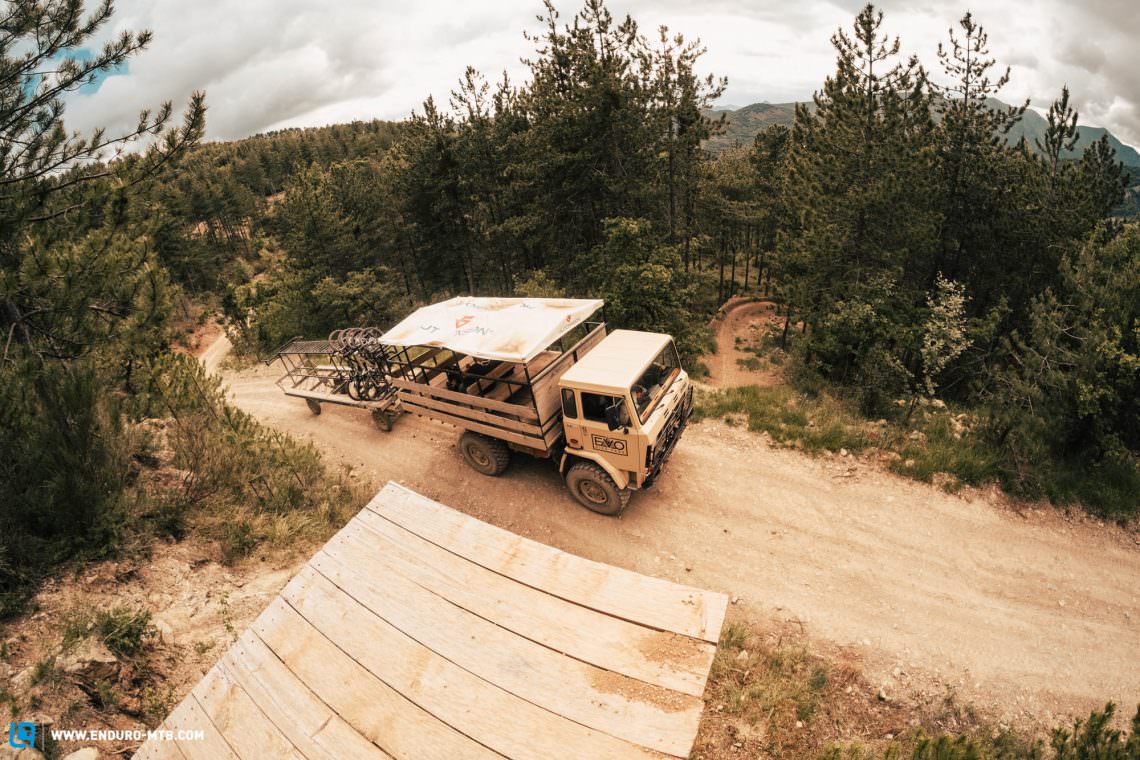
Is it always better to have more options? The geometry of Specialized Enduro and Kenevo SL
Both the Kenevo SL and Enduro adopt Specialized’s “style specific sizing” concept. The super-shirt seat tube across all sizes allows you to pick your frame based on your personal preferences and riding style rather than the length of your legs. Particularly with the Enduro, you should be able to choose from at least two frame sizes. If you spend most of your time blasting down rough trails and high-speed downhill tracks, you should pick a larger frame for more composure. If you prefer playful handling for an active riding style and quick direction changes, we recommend downsizing. Despite using identical seat tube lengths, the sizing concept doesn’t work for the S-Works Kenevo SL. Here the problem is the limited insertion depth of the seat tube (size S4), which prevents you from pushing the 170 mm Reverb AXS dropper all the way into the frame. For our 1.86 metre tall chief of testing Felix, the saddle was simply too high with the dropper fully expended. Alternatively, we recommend a dropper post with a low stack height like the OneUp V2, which ensures more freedom of movement.

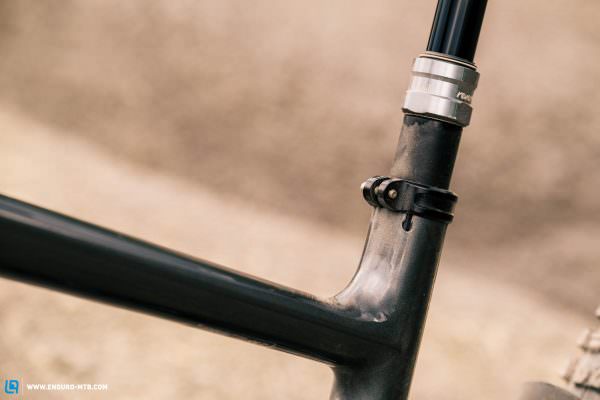
Apart from this, both bikes share fairly similar geometries across all sizes. Particularly striking is the slack head angle, which makes them suitable for steep trails and rowdy trail sessions. On the Enduro, a flip-chip in the shock mount allows you to make small adjustments to the geometry and adapt the riding position to your liking. The Kenevo SL takes it one step further, letting you switch between six geometry settings using different headset cups and a flip-chip in the chainstays. We recommend starting with the headset cup set to the middle position and the flip-chip in the high setting.
The geometry of the Specialized S-Works Enduro
| Size | S2 | S3 | S4 | S5 |
|---|---|---|---|---|
| Seat tube | 400 mm | 420 mm | 440 mm | 465 mm |
| Top tube | 591 mm | 619 mm | 644 mm | 670 mm |
| Head tube | 95 mm | 100 mm | 110 mm | 120 mm |
| Head tube | 63,9° | 63,9° | 63,9° | 63,9° |
| Head angle | 76° | 76° | 76° | 76° |
| Chainstays | 442 mm | 442 mm | 442 mm | 442 mm |
| BB height | 347 mm | 347 mm | 347 mm | 347 mm |
| Wheelbase | 1217 mm | 1246 mm | 1274 mm | 1302 mm |
| Reach | 437 mm | 464 mm | 487 mm | 511 mm |
| Stack | 616 mm | 620 mm | 629 mm | 638 mm |
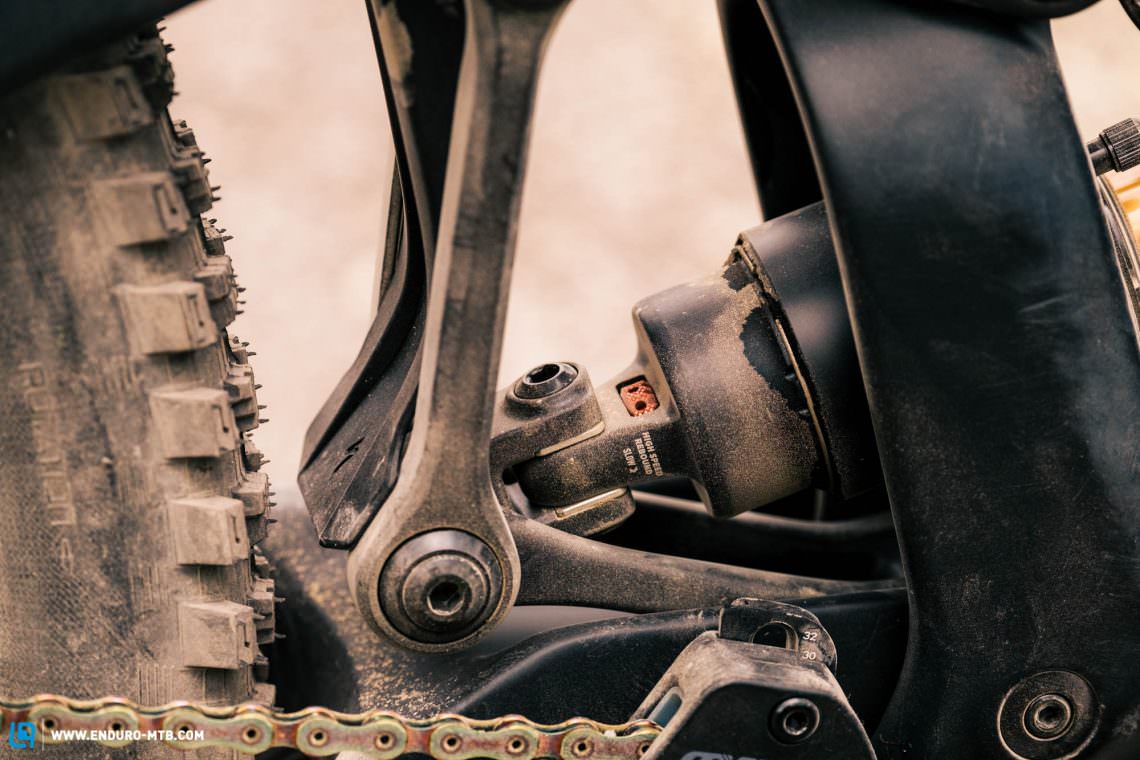
The flip-chip in the chainstays allows you to adjust the geometry of the Enduro by around 0.5°. For rowdy bike park sessions, we recommend the low setting. That said, on technical trails, the Enduro is also fun in the high setting.

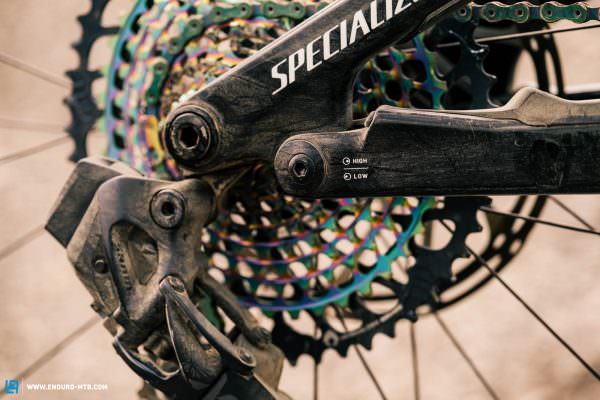
The geometry of the Specialized Turbo Kenevo SL
| Size | S2 | S3 | S4 | S5 |
|---|---|---|---|---|
| Seat tube | 400 mm | 420 mm | 440 mm | 465 mm |
| Head tube | 105 mm | 115 mm | 125 mm | 135 mm |
| Head angle | 63,5° | 63,5° | 63,5° | 63,5° |
| Seat angle | 76° | 76° | 76° | 76° |
| Chainstays | 447 mm | 447,3 mm | 447 mm | 447 mm |
| BB Drop | 350 mm | 350 mm | 350 mm | 350 mm |
| Wheelbase | 1228 mm | 1258 mm | 1287 mm | 1316 mm |
| Reach | 435 mm | 460 mm | 485 mm | 510 mm |
| Stack | 618 mm | 626 mm | 635 mm | 644 mm |
Turbo, pedalling or shuttling? Kenevo SL vs Enduro on the climbs
Despite the near-identical riding positions the outcome of the climbing duel is clear right from the start. The relatively slack seat tube angle and long front ensure a roomy and slightly stretched pedalling position on both bikes. If you spend lots of time climbing steep trails, we recommend pushing the saddle all the way forward for a more central seating position. However, on very steep sections, the Enduro throws in the towel and prefers to get to the trailhead on fire roads with moderate gradients. Here, the Kenevo SL tags along willingly in the two lower support modes, revealing its electric nature with a faint humming noise and delivering its power sensitively and discreetly on long climbing stretches. The Enduro and Kenevo don’t mind riding to the top together. On steep, technical climbs, the Kenevo SL requires careful line choice and the right gearing to overcome steps and ledges using the most powerful support mode. Under full load, the small SL 1.1 motor is clearly audible. While the Enduro is the quieter bike uphill (except for the high-pitched wheezing coming from your lungs) the Kenevo SL is clearly the stronger climber. That being said, with both bikes you’ll still have to rely on a shuttle truck or lift if you want to squeeze in as many dowhill laps as possible in one day.
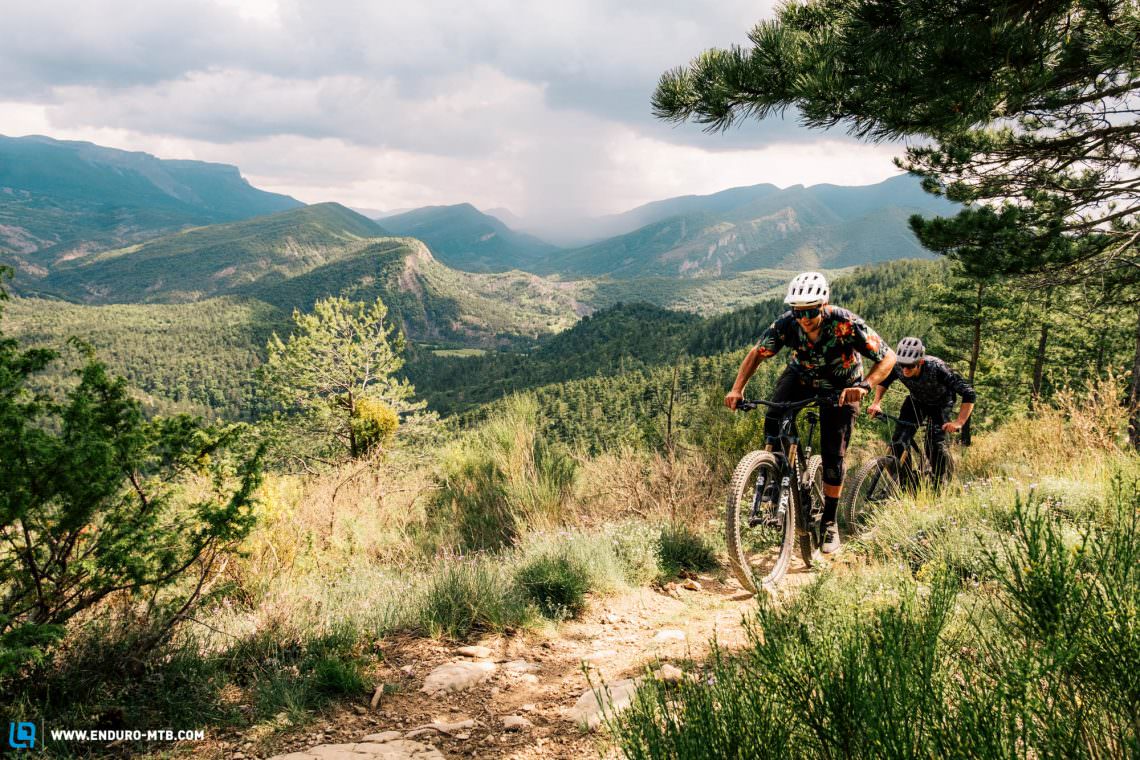
With its 250 W Specialized SL 1.1 motor, the Kenevo SL pulls past the Enduro without too much effort. That said, thanks to the adjustable support levels, it will also happily tag along its analogue counterpart on moderate climbs.

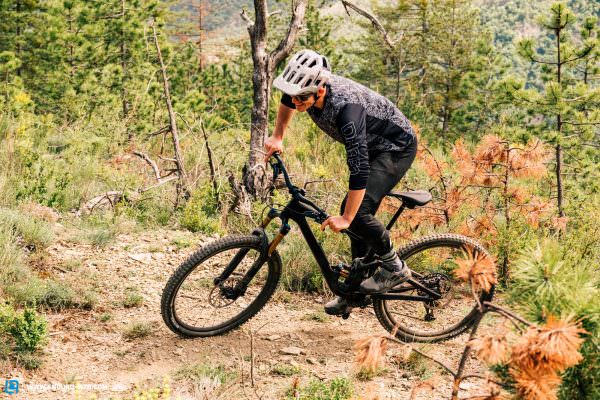
Send it! Kenevo SL vs Enduro downhill
Drop the saddle and kick off the party? Going downhill, both the Kenevo SL and Enduro convey huge amounts of confidence. On both bikes, the low bottom bracket ensures a central riding position and integrates the rider between the big wheels. With its higher front, the Kenevo ensures a more upright riding position, leaving you free to scan the trail ahead. With all spacers under the stem, the Enduro has the same downhill-oriented riding position. On the trail, the Enduro lives up to its name: Specialized’s potent enduro bruiser was designed for speed and tends to get bored on simple and smooth flowing trails. While it’s a lot poppier and more agile than the Kenevo SL, making it easier to manual out of berms and play with the terrain, both bikes are most in their element on fast trails, big jumps and steep rock gardens. Technical singletracks and rough enduro stages are where they really come to life. Whether you go analogue or electric, the capable suspension swallows up roots and smaller rocks, converting the roughest of trails into a pump track. At the same time, the suspension generates tons of traction but still offers enough support to gap nasty trail sections. Provided you’re carrying good speed, you’ll hardly notice the extra weight of the Kenevo SL when popping off ledges. If you mess up your line and slam the rear wheel into an obstacle, the Kenevo SL passes on the hits onto your ankles more obviously than the Enduro which, thanks to its less compromised suspension kinematics, ensures an overall smoother ride.
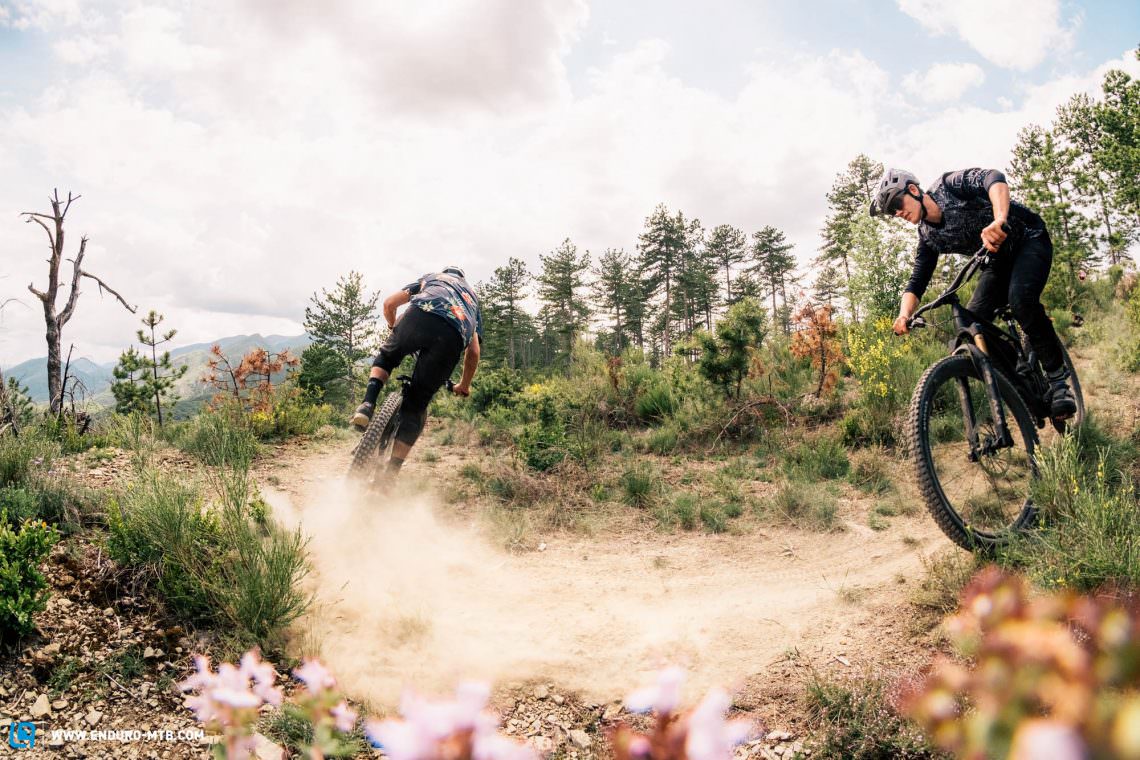
In open corners, the Kenevo SL pulls past the Enduro without batting an eyelid. The low and central centre of gravity of the Light eMTB really helps generate traction.
Open corners on loose terrain and steps? “Hell yeah!” yells the Kenevo SL at the top of its voice while pulling past the Enduro on the inside line. Despite the identical tire setup, the Light eMTB generates a smidge more traction and is more intuitive to control. Here the additional weight of the battery in the down tube plays an important role, helping weight the front wheel and generate traction without the rider having to actively shift their weight forward. On steep descents, the Enduro catches while braking. That may sound a little weird, but that’s exactly what happens! While the CODE brakes with big rotors provide powerful and reliable deceleration on both bikes, the extra mass of the Kenevo SL requires you to get on the brakes a tad earlier. Here the additional weight and the limited freedom of movement due to the short insertion depth of the seat tube put the Kenevo SL at a clear disadvantage.
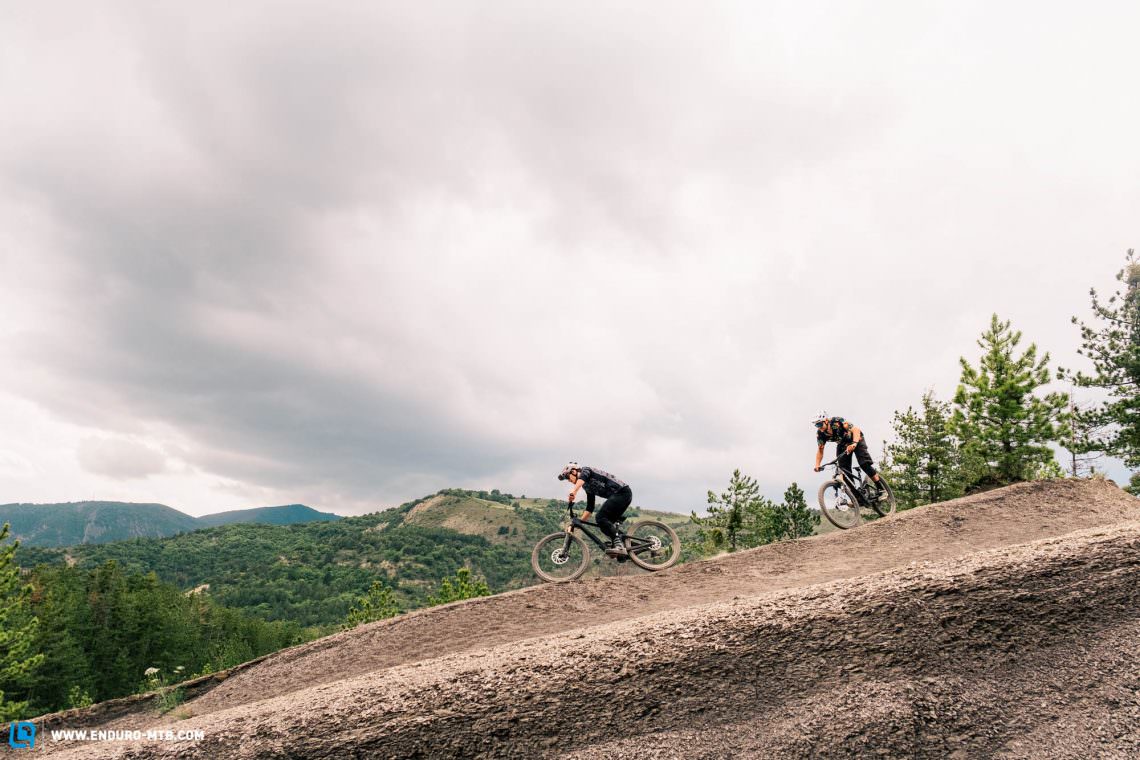
On steep descents and slippery terrain, the Kenevo SL requires a longer braking distance.


Needless to say, the limited freedom of movement and extra mass also have a significant effect on the handling of the Kenevo SL on big bike park jump lines. Nevertheless, both bikes feel plush and safe at high speeds, encouraging you to approach big gaps without hesitation. Through tall berms and on big jumps, both the Enduro and Kenevo SL feel predictable and provide sufficient support. Once in the air, the Kenevo SL is reassuringly composed and very easy to control, allowing even inexperienced riders to collect air miles and build confidence to progress onto bigger jumps. That being said, the Kenevo SL prefers to leave fat whips and stylish tabletop tricks to the Enduro, which offers more freedom of movement and is easier to get sideways mid air. On the other hand, the lower weight makes it more susceptible to sidewinds and mistakes, requiring better riding skills and more experience.

While the Kenevo SL is an outstanding (and safe) training companion for inexperienced riders on big jumps, the Enduro prefers to fly through the air sideways.
Conclusions
Never has a battle at ENDURO been as close as the shootout between the Specialized S-Works Turbo Kenevo SL and the S-Works Enduro. Both bikes are potent, high-quality bruisers that love getting rowdy on fast, rough bike park tracks. With its intuitive handling, the Kenevo SL inspires more confidence and is best suited to beginners and riders who live in areas without a lift or shuttle service. If “rowdy” doesn’t cut it and you want to crank it up to eleven, the Enduro is an even more capable , faster and yet more playful bruiser than the Kenevo SL – and it’s also about five bike park season tickets cheaper! Even without a motor, the Enduro secures victory in our ultimate bruiser duel.
Find out more about the bikes here: specialized.com

Test rider Nils and editor Peter didn’t have fun at all testing the S-Works…
Did you enjoy this article? If so, we would be stoked if you decide to support us with a monthly contribution. By becoming a supporter of ENDURO, you will help secure a sustainable future for high-quality mountain bike journalism. Click here to learn more.
Words: Photos: Diverse




